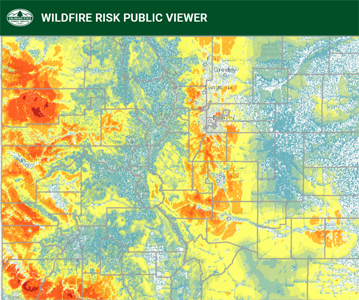Unseasonably warm temperatures along with one of the driest winters on record have placed the majority of Colorado in drought conditions. Just this weekend two wildfires broke out, one west of Idaho Springs and another down by Ken Caryl. When fires break out it can often be difficult to find status updates and other critical information. News coverage may include only high-level general information that will not be specific enough if you can see smoke on the horizon. I have found that social media feeds from the County Sheriff’s office or the Office of Emergency Management provide the best details early on. Each county sheriff works differently, some actively use Twitter, others use Facebook so it may take a little searching to locate the feed. The Colorado Division of Homeland Security and Emergency Management has pulled together a list of emergency managers at the county level along with information on how to sign up for emergency alerts.
We often hear the phrase “wildland urban interface” used when fire fighting agency representatives give updates on a wildfire. According to the U.S. Fire Administration, the term wildland urban interface refers to “the zone of transition between unoccupied land and human development. It is the line, area or zone where structures and other human development meet or intermingle with undeveloped wildland or vegetative fuels.” Many of us living in the Front Range foothills fit into this category.
 If you are wondering what the risk of fire might be for your home or business, the Colorado Forest Service has a wonderful interactive tool called the “Wildfire Risk Public Viewer.” Type an address in to the search box (upper right corner) to zoom in on the map. Then use the Map Themes on the left hand side to display a variety of data including wildfire risk, burn probability, surface fuels and a layer for the wildland urban interface which shows the density of housing along wildland areas. Living in an at-risk area myself, I found this fascinating.
If you are wondering what the risk of fire might be for your home or business, the Colorado Forest Service has a wonderful interactive tool called the “Wildfire Risk Public Viewer.” Type an address in to the search box (upper right corner) to zoom in on the map. Then use the Map Themes on the left hand side to display a variety of data including wildfire risk, burn probability, surface fuels and a layer for the wildland urban interface which shows the density of housing along wildland areas. Living in an at-risk area myself, I found this fascinating.
No one wants to imagine having a fire on their doorstep, but it is important to prepare in case the threat becomes real. The Colorado Division of Homeland Security and Emergency Management’s Wildfire website has videos and guides on how to prepare and defend yourself, family and home from a wildfire. Their “Be Prepared” site is also a great resource with suggestions and steps on how to plan in case of an emergency.
These publications from our collection may also be of interest:
- Colorado Climate Change Vulnerability Study
- Home ignition zone: A guide to preparing your home for wildfire and creating defensible space
- Planning for recovery from wildland fire
- Post-wildfires hazards: mud slides, debris flows
- 2021 Wildfire preparedness plan: Report to the Governor and General Assembly
For more information about drought conditions in Colorado, visit the Colorado Climate Center (at Colorado State University).
- Have you Registered to Vote? - September 17, 2024
- The Castlewood Canyon Flood of 1933 - August 3, 2023
- Holiday Selections - December 22, 2022